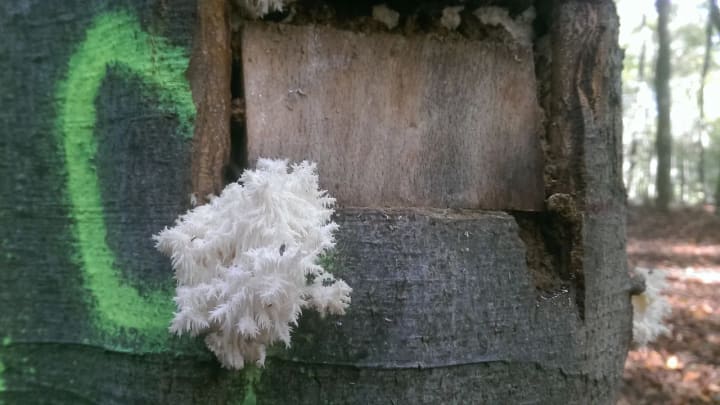
At around 1,100 years old, and almost 11m (36ft) in girth, the Big Belly Oak is the oldest tree in Savernake Forest in south-west England. A tiny sapling at the Battle of Hastings in 1066, Big Belly Oak has lived through the War of the Roses, the Black Death, the English Civil War, the Industrial Revolution and two world wars. Now gnarled and knobbly, Big Belly Oak’s trunk is strapped up with a metal girdle to keep it from falling apart.
While an ancient tree like this is impressive at a distance, take a look inside and you will see something even more intriguing.
Oak polypore fungi and stag beetle larvae feast on the dead heartwood, adult stag beetles sup the sugary liquid from the "sap runs", the living layers of wood which transport water and minerals throughout the tree. Hover flies lay eggs in water-filled rot holes, rat-tailed maggots devour leaf litter and violet click beetles eat up wood mould that is rich with faeces and other remains, accumulating over a century. Knothole moss and pox lichen cling to the bark in rainwater channels. Barbastelle bats hibernate in crevices and under loose bark. Woodpeckers and nuthatch enlarge holes for nesting, while owls, kestrels, marsh tit and tree-creeper move in to ready-made cavities.
These rich pockets of life are a secret world, a diverse habitat teeming with insects, fungi, lichen, birds and bats. The ancients of our forests provide essential food and shelter for more than 2,000 of the UK's invertebrates species. In Savernake Forest alone, these trees are home to nearly 120 species of lichen, more than 500 species of fungi, and other important wildlife such as the elusive white-letter hairstreak butterflies.
We face losing these micro-worlds as, one by one, the ancient trees of today are dying and there are not enough ready to replace them.
The ancients of Savernake Forest are something of an anomaly in the wider landscape. A thousand years ago, Savernake was wood-pasture grazed with livestock. Then from the 12th Century it was a royal hunting forest with woodland, coppice, common land and small farms. In the 20th Century, that picture changed dramatically. Worldwide over a third of primary forests – ones that have been undisturbed by humans for over 140 years – were cut down between 1900 and 2015. The loss is attributed to land-use change like the creation of farms or housing developments, and tree harvesting for wood. In Britain, although the canopy cover grew throughout the 20th Century, most of this new growth was down to planting new saplings – the country has lost almost half of its ancient woodland since the 1930s.

The way we manage forests has changed, explains Paul Rutter, woodland advisor for Plantlife and project officer at Ancients of the Future, a collaboration between conservation charities Buglife, Plantlife, and the Bat Conservation Trust. The intensification of agriculture has meant the removal of many hedgerows and trees that grow within them, as fields have been made larger. Traditional forest management practices have largely been replaced by plantation forestry and whole-tree extraction. Ancient trees are becoming smothered by overcrowded canopies, saplings, shrubs and brambles. Many have been felled for timber or urban development. Add to that an increase in tree diseases and the challenges of climate change. The result is that fewer trees are surviving – or being allowed to grow – into their old age.
Which means that the race to old age is on. The Ancients of the Future has an unusual aim: to speed up the ageing process for some trees to ensure these habitats don't disappear for good.
Tree time
"In the tree world everything happens slowly," says Rutter. "We call it tree time."
Trees reach their ancient (or senescent) phase of life at different ages. For beech this is from 225 years old, oaks from 400 years and yew 900 years. During this phase the trunk hollows, holes and cavities appear and deadwood reaches above the living canopy.
It can take up to 300 years before heart-rot, the decay at the centre of an ageing tree, is established enough that insects can start moving in and laying their larvae, says Rutter. "It becomes a complex ecosystem. The ancient trees that we have today, ones that are 300-900 years old – perhaps older – support an incredibly wide range of species."

Take oaks, which can live for more than 1,000 years and grow to more than 10m (32ft) in girth. A recent study found that oaks native to Great Britain support 2,300 other species, of which 326 are completely dependent on them. The flower and leaf buds are eaten by caterpillars of purple hairstreak butterflies and holes provide nesting spots for the pied flycatcher, redstart and marsh tit.
In autumn, mammals like squirrels, badgers and deer feed on the acorns. The leaves fall to the ground and form a rich leaf mould where invertebrates including stag beetles and fungi such as the oakbug milkcap thrive. The resident insects, in turn, are a vital food source for many birds and bats.
Alice Parfitt, conservation officer at Buglife and Ancients of the Future project officer, says: "Invertebrates that rely on these habitats provide all sorts of services such as pollination or processing the decay of materials. The really rare invertebrates that we’re looking at in this project – we don’t know what they do. We don’t know enough about them."
Stephanie Skipp, a PhD student at University of East London, is investigating beetles that live in decaying wood. "Beetles perform an overwhelming number of services throughout different ecosystems," she says, "and the presence of deadwood beetles is vital for maintaining woodland health."
Many deadwood beetle species recycle the nutrients of woodlands. Working alongside fungi, bacteria and other invertebrates, they break down dead wood and return the nutrients back to the soil. Some deadwood beetles are predators or parasitoids (insects whose larvae live as parasites) to other insect species and restrict population growth of potential pests. Others have recently been found to be pollinators.

"With current trends towards general invertebrate decline, we need to support as many pollinators as possible," says Skipp.
Fast forward
"For centuries, trees have been pollarded – cut and allowed to regrow. This encourages new growth and was used to produce fodder for livestock and timber," says Rutter. "The trees grew hollow inside and we’ve now found that they are rich habitats for some very demanding species of beetle and other insects. Veteranisation is based on this idea."
Veteranisation is the practice of damaging younger trees in order to initiate decay sooner than it would occur naturally. The hope is that habitats usually seen in older trees will begin to develop much earlier. Veteranisation is not new, explains Rutter, but it is not well documented. Only recently has research been initiated to monitor the success of veteranisation techniques.
An international trial, started in 2012 and set over 20 sites in Sweden, England and Norway, is in the process of evaluating the veteranisation of almost 1,000 oak trees. The methods applied include creating woodpecker-like holes, breaking or ringbarking lower branches or the trunk to mimic damage from animals such as deer or horses, and creating nest boxes for birds and bats. The project is planned to take 25 years, until 2037, so the results have yet to be fully analysed.
"The signs are very promising," said Rutter. "Most of the trees are responding well, healing and continuing to grow. Birds, bats and insects have all been found living in the artificially created niches."

Back in the UK, Ancients of the Future has been trialling these same methods on beech and oak trees. Rutter says, after two years, cavities are starting to appear. "Normally, you’d have to wait for a lightning strike or a limb falling off for the decaying process to start. That can take hundreds of years. These are vigorous, young trees and niches are already beginning to develop."
The violet click beetle, present at just three sites in the UK, is the main target of Skipp’s study. They require wet wood mould at the base of beech trees. Skipp has been installing beetle boxes for them – wooden structures designed to mimic hollows that form at the base of ancient trees. The boxes have an entrance at ground level and are filled with decaying wood, similar to the nutrient-rich wood mould that you might find naturally.
"This beetle requires high-quality habitats," she says. "So by protecting it, you are conserving important features that benefit a whole suite of other species too."
Beyond their usefulness, says Skipp, deadwood beetles exhibit some fascinating diversity. Some have evolved flat bodies, allowing them to live in the ultra-thin cracks behind tree bark. Others are perfectly cylindrical, so they can create and pass through complex tunnels in the wood "like a tube train trundling through the London Underground".
Parfitt adds: "Invertebrates need deadwood in different tree species and in different forms. So, it’s important to veteranise the trees in different ways."
To that end, scientists have been exploring another method. It is thought that inoculating young trees with fungi could accelerate the ageing process even more.
Mysterious fungi
I bat a mosquito away as it homes in on my flesh. "Mosquitos love me," I say. Lynne Boddy, professor of fungal ecology at Cardiff University who is guiding me through the ancient woods of the Wye Valley, tells me it is because I give off the same scent as fungi, which do it to attract insects. Perhaps we have more in common with fungi than we realise.
Neither plant nor animal, fungi are in a class of their own. They are found in all parts of the world and but, still, we know relatively little about them. As of today, 148,000 species have been identified but scientists believe that more than 90% of species remain unknown.

We do know, however, that they play a vital role in our ecosystems. Fungi decompose dead material into the building blocks of new soil. Fungi can also break down living material too – including trees. Fungi are the main drivers of wood decay, and a crucial resource for many invertebrates is a living tree with columns of fungal decay in the heartwood.
Heart-rot fungi only move in when trees are mature, feeding on the dead wood at the centre of an ancient tree. When holes begin to form, the wood softens then insects and other species such as woodpeckers are able to excavate it further. Over time, a hollow forms and the cavity floor is lined with wood mould, a rich soil-like mulch.
"Heart-rot species are key," says Rutter. "These fungi are able to break down the lignin, the very hard part of the wood which is normally incredibly indigestible. Many heart-rot fungi happily eat the central dead wood without harming the living tissue on the outside – and can co-exist with a tree for 600 or 700 years. We want a tree to live a long time so the habitats can continue for as long as possible."
To try and mimic this process in younger trees, Ancients of the Future is growing heart-rot fungi on blocks of wood in the lab, inserting the blocks into holes cut in young trees and recovering them with bark. They are left that way for a few years, then the blocks are removed to see if the fungi have taken hold inside the tree.
The project is not the first to try this technique – fungi inoculation has been trialled before in North America where researchers found that fungal inoculation could reduce decay time from 100 years to just three when used in combination with traditional methods.
Boddy explains why this new method of veteranisation may work better than previous methods: "We’re putting the fungi we want where we want it, rather than just hoping it turns up."
She explains that the hollowing of ancient trees by fungal decay, previously seen as detrimental, is a natural part of the ageing process and can even prolong the lives of trees, feeding them nutrients from the inside.
Boddy's team has been using a new, minimally damaging DNA sampling technique to analyse the inoculated wood. It means the researchers are able to take a much smaller sample from the tree and get much more detailed information.
"Fungi are all around us," says Boddy. "Inside every tree trunk, every leaf, every stem, every bit of plant that’s decaying on the floor, in the soil beneath our feet. But we can’t see them which makes studying them very difficult. Now that we can extract DNA we can see exactly what’s there."

Boddy is optimistic that fungal inoculation could help speed up the ageing process, and that it's possible to bridge the gap between the ancient trees of today and those of the future. But it’s still too soon to tell. Variables such as tree and fungus species, and climate change will have an impact. And we still know very little about heart-rot – how fungi get inside a tree in the first place, how their communities change over time or how that affects decay.
These efforts are also a temporary fix. So, what can we do differently to ensure we never see a generational gap like this again? The Ancient Tree Forum offers land owners advice on how to care for their ancient trees – putting up barriers to protect them from livestock, clearing nearby vegetation that is competing for light, creating a root protection zone and propping up heavy limbs or bracing ageing trunks.
The Woodland Trust calls for full legal protection for all ancient trees to prevent further loss, and enforcement of government urban development policies that prevent encroachment on ancient woodlands. Such woodlands could be identified through inventories and more research done into the buffers necessary to protect ancient woodlands from nearby development sites.
In the context of the global biodiversity crisis, with many species in sharp decline, the intricate worlds inside ancient trees might seem like a small piece of the puzzle. But without the unique habitats provided by ancient trees, the health of the wider forest ecosystem – from fungi to butterflies – could be compromised.
"We need to think beyond our own lifetimes and look after the trees we’ve got now, to give them a chance to grow into ancients," says Rutter. "Trees are fragile, complex chemical factories and major hubs for biodiversity. Without them, many species won’t survive."
About the Creator
Fra Tusha
stay hungry, stay foolish.






Comments
There are no comments for this story
Be the first to respond and start the conversation.